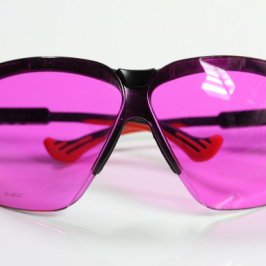![Color Blindness Upgraded With Color-Correction Glasses [Interview] color blindness](http://guardianlv.com/wp-content/uploads/2016/09/Mark-Changizi.jpg)
Now what you might not know is that there are many different forms and variations of color blindness. When you think about how a person becomes color blind, it is important to note that the most common cases are inherited. Other more dangerous causes can be disease related. Women are more likely to pass it on through birth by what scientist call a defective X chromosome. However, it is men that suffer the most. In color blindness, there are a reduced number of cone cells in the retina of the eye. The retina is responsible for color vision. Color blindness affects one in 20 men as compared to women who are one in every 200.
Depending on one’s occupation in life, there are not too many ramifications for being color blind outside of looking weird with clothing selections. For some, their job critically depends on their ability to identify very specific colors. Could you imagine someone on the local police department’s bomb squad asking a teammate which wire is the red one? This would be dangerous.
I recently had the opportunity to sit down and have a chat with someone who decided to tackle the issue of color blindness head on. Dr. Mark Changizi, co-founder of the O2 Amp glasses, helped design lenses that claim to correct the red-green color deficiency that exists in so many. In 2006, while attending Caltech he discovered that much like us, primate’s color vision is optimized for seeing oxygenation modulations in the blood beneath the skin. He began doing research and before he knew it he there was tons of data supporting his discovery. This put Dr. Changizi and his colleagues in the unique position to design and patent this technology.
During the interview with Dr. Changizi, I had the distinct opportunity to listen as he shared the concept for the O2 Amp glasses as well as influences and challenges. Here are a few insights shared from his perspective:
What or who has been your major influence or inspiration to develop the O2 Amp glasses?
After coming up with a research discovery on color vision, a colleague and I decided we could utilize the results to enhance color vision and perception of certain kinds of clinical states. The enhance vasculature and bruising beneath the skin. Now they are being tested to aid those with color blindness, although the lenses inhibit the perception of yellows and blues.
Can you expound on the research or color vision discovery?
A dog does not see in full-color vision, but we primates have a third dimension of color vision that other mammals do not have. For many years, it was thought that the ability to see reds and greens ![Color Blindness Upgraded With Color-Correction Glasses [Interview] color blindness](http://guardianlv.com/wp-content/uploads/2016/09/glasses.jpg)
You can see health states, blushing or other signals on the skin. When you look at how blood changes as it oxygenates and deoxygenates, it’s in a very particular part of the spectrum that’s subtle and hard to see, unless there are cones, or light-sensitive cells in the retina that detect color, just in the spot where primates have a pair.
What challenges occurred as you took the theory to realization?
When we approached the concept of the glasses, my colleague Tim Barber and I figured out some filters that would help our eyes see the enhancement of red-green color deficiency. Of course working with fabricators and others who had the materials needed to make the model. It was difficult in that we had to communicate what we wanted to people who were engineering it. We went back and forth several times getting things just right. Technically, we had to be closely connected to designing to make sure the core purpose was achieved.
Originally, who were these glasses created for?
Well in conception, we had a certain demographic in mind. Those in the field of medicine as clinicians were our primary thought. Think of it, the better you can see veins and the oxygenated blood below the skin, the better you can perform your job. However, we found that many others found the enhancement to be beneficial.
You mentioned that your father was a medicine as well. Explain that experience.
As a colorblind doctor, he knew very well that he was handicapped in certain areas. From the foundation of modern medical care, physical appearance has been a large bearing on diagnosis. Therefore, if they cannot look at your eye or skin color variations, they are severely disadvantaged with being able to correctly diagnose. We call this “health blindness.” In fact, I did a TED Talk about this some time ago where I discussed the effects on doctors who are colorblind. The things someone like myself takes for granted, those who are “health blind” would miss.
How long did it take to develop the glasses?
Once we had the idea, it took nearly three years to be ready for manufacturing. It gets technical when you are explaining the variances to them. Like telling them, we need the filter technology to block narrow bands of light and tweak their wavelengths. Our largest time was spent with finding the right companies to work with and who could produce exactly what we needed.
Where can consumers find a pair of glasses for themselves?
For any consumer, they can go directly to Amazon to purchase a pair. If others in a clinical setting would like them, they can go directly to our website and contact us directly for orders. We have various styles, frames, and mirrored effects as well.
Guardian Liberty Voice appreciates Dr. Changizi for taking the time to share his passion and perspective with our readers. It was a pleasure to speak with him and we look forward to further opportunities to share upcoming news as he continues his mission of enhancing the lives of those with perceived deficiencies.
It is obvious that color blindness affects us all to the degree we rely on that ability. There seems to be a major difference on the impact it has on a truck driver versus an operating room technician. ![Color Blindness Upgraded With Color-Correction Glasses [Interview] Early Jackson](http://guardianlv.com/wp-content/uploads/2016/09/Early-Jackson-GLV-1.jpg)
On a personal note, I have been blown away by the correction I experience when wearing these glasses. Colors that were drab and lifeless seemingly come alive with them. I finally realize why I get funny looks when I pair certain clothing together. What is amazing is what I have missed and how easily it is to take that kind of vision for granted.
Interview by Early Jackson
(Edited by Cherese Jackson)
The Oxy-Iso glasses use a patented technology developed from the discovery that the reason we have color vision is actually for seeing blood under the skin in order to sense emotions and health. This theory, made by Dr. Mark Changizi, that color vision allows us to “read” fellow humans better by seeing into their underlying physiological state, led to the creation of O2Amp.
Source:
Dr. Mark Changizi
Photo Credit:
All Images Courtesy of Dr. Mark Changizi



![Color Blindness Upgraded With Color-Correction Glasses [Interview] color blindness](http://guardianlv.com/wp-content/uploads/2016/09/o2amp_newLogoForFrames-glasses.jpg)




